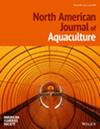重复硫酸铜处理对幼年瓦勒耶鱼的生长和存活没有影响
IF 1.3
4区 农林科学
Q3 FISHERIES
引用次数: 0
摘要
方法 每隔一天用 0 或 0.76 mg/L CuSO4 处理养殖池 5 次,然后连续 14 天不处理;在 50 天内共重复处理 10 次。硫酸铜处理的半衰期约为 60 分钟。结果经硫酸铜处理和未处理的鱼的存活率分别为 96% 和 85%,没有统计学差异。两组鱼的体重没有差异,经处理的鱼体重为 25.3 克,而未经处理的对照组鱼体重为 25.2 克。在研究期间,两组鱼的体重都增加了 400% 以上。两组鱼的体长均无差异,处理组鱼的平均体长为 14.6 厘米,未处理组鱼的平均体长为 14.5 厘米。本文章由计算机程序翻译,如有差异,请以英文原文为准。
Repeated copper sulfate treatments have no effect on growth and survival of juvenile Walleye
ObjectiveAn experiment was conducted to evaluate the effects of repeated copper sulfate (CuSO4 ) treatments on the growth and survival of juvenile Walleye Sander vitreus .MethodsCulture tanks were treated with 0 or 0.76 mg/L CuSO4 every other day for five exposures, then were not treated for 14 consecutive days; this regimen was repeated for a total of 10 exposures over the course of 50 days. Copper sulfate treatments had a half‐life of about 60 min. The study was conducted in flow‐through well water at ≈1.5 L/m and 23.8°C.ResultThe resulting survival data for CuSO4 treated and nontreated fish was 96% and 85% survival, respectively, and not statically different. There was no difference in weight, with treated weighing 25.3 g compared to 25.2 g for nontreated control fish. Both groups had weight increases of over 400% during the study. Neither group differed in length, with treated fish reaching a mean length of 14.6 cm and nontreated reaching a mean length of 14.5 cm.ConclusionThe results indicate that repeated CuSO4 treatments had no effect on Walleye growth or survival.
求助全文
通过发布文献求助,成功后即可免费获取论文全文。
去求助
来源期刊
CiteScore
2.50
自引率
0.00%
发文量
46
审稿时长
18-36 weeks
期刊介绍:
The North American Journal of Aquaculture publishes papers on new research and practical experience in all areas of intensive and extensive fish culture. Topics include broodstock selection and spawning, nutrition and feeding, health and water quality, facilities and production technology, and the management of ponds, pens, and raceways.
The journal will consider papers dealing with ways to improve the husbandry of any aquatic species—marine or freshwater, vertebrate or invertebrate—raised for commercial, scientific, recreational, enhancement, or restoration purposes that may be of interest to practitioners in North America. Its scope includes both basic and applied science, but applied scientific endeavors—including practical experiences, descriptive studies, and other nontraditional, but pertinent works—are emphasized.

 求助内容:
求助内容: 应助结果提醒方式:
应助结果提醒方式:


